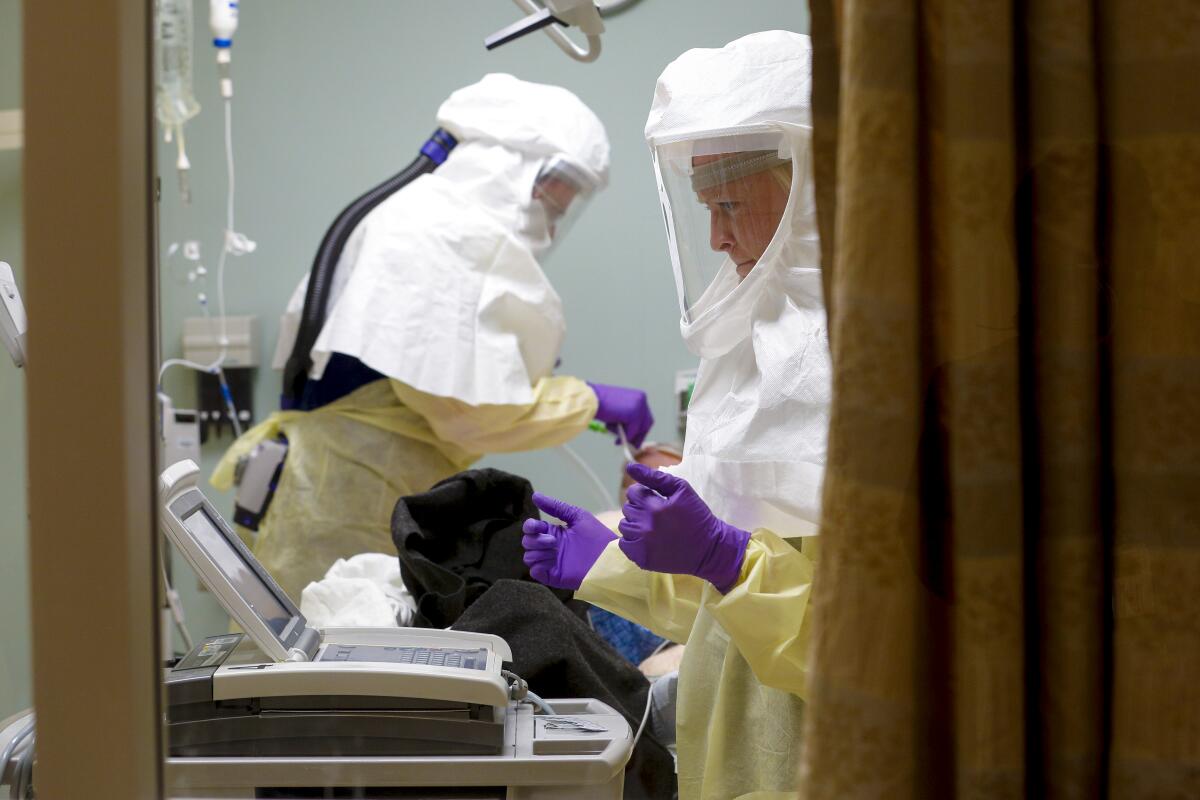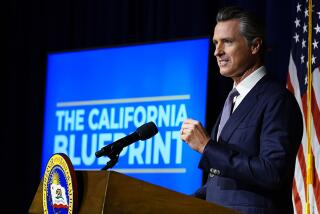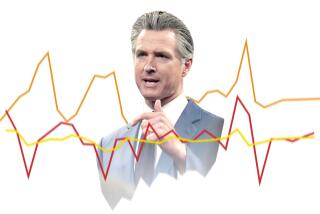California’s early coronavirus efforts will cost $7 billion, Gov. Gavin Newsom says

- Share via
SACRAMENTO — Budget advisors to Gov. Gavin Newsom told California lawmakers on Friday that the state’s initial efforts to combat the coronavirus will total at least $7 billion, with additional costs expected before year’s end.
The estimate, contained in a letter to the Legislature’s joint budget committee, is the first comprehensive look at the fiscal impact of responding to the pandemic. It does not include substantial costs already borne by city and county governments across the state.
“This impact is expected to be immediate, affecting fiscal year 2019-20, and will continue into fiscal year 2020-21 and additional years depending on the pace of recovery of local, state and national economies,” wrote Keely Bosler, the governor’s finance director, in the letter to lawmakers.
The Newsom administration also projected what could be record-setting unemployment in California, which topped 12.9% in 2009.
“Due to the scope of the COVID-19 pandemic, unemployment could peak at a level higher than the Great Recession,” Bosler wrote.
The $7-billion estimate includes the $1 billion in spending authorized by the Legislature last month, the last act of lawmakers before they canceled all hearings and legislative sessions in response to public health warnings. The two houses are scheduled to reconvene in Sacramento as early as May 4, with two coronavirus-related hearings to take place before then.
On Monday, the governor’s advisers estimated about $362 million of the $1 billion in legislatively approved funds had been spent. That includes prevention programs focused on the homeless population and the state’s share for three months of COVID-19 services at St. Vincent Medical Center near downtown Los Angeles.
Few, if any, crises in modern times have hit the state’s finances faster and more deeply. The Newsom administration said the $7 billion in costs will come due before June 30. Much of the money, they told lawmakers, will be spent on personal protective equipment for healthcare and emergency workers as well as medical supplies and sweeping public health initiatives.
Included in that amount is a $990-million two-month agreement to purchase protective masks, most of which are the much sought-after N95 masks used by medical and emergency personnel. The chairs of the Senate and Assembly budget committees told Newsom on Thursday that he needs to provide detailed information on the sellers of the equipment and other details of the quickly signed deal.
Much of the initial $7 billion spent by the state is expected to be reimbursed by the federal government. Following President Trump’s disaster declaration for California last month, the Federal Emergency Management Agency generally covers 75% of most costs. The independent Legislative Analyst’s Office wrote last month that eligible expenses could include “disinfecting eligible facilities, providing temporary medical facilities, providing temporary housing for homeless, purchasing equipment and supplies (such as face masks and other personal protective equipment), and directing law enforcement to provide necessary assistance.”
Far larger expenses are likely on the horizon. California’s health and human services programs, including government-subsidized medical care and welfare assistance, are available to any citizen who meets income requirements. Some state residents who are in the U.S. illegally are eligible for healthcare under the Medi-Cal program. State officials said they expect expenses to spike in these programs too.
Legislators and longtime California budget watchers alike had already warned of a swift about-face in government finances, predicting that the state’s projected $21-billion budget reserves could be completely consumed by both immediate and longer-term effects of the crisis. On March 24, the Newsom administration told lawmakers it was already preparing to scrap many of the ambitious plans proposed by the governor in his January budget submission.
“We’ve been working overtime on our budget,” Newsom told reporters Tuesday. “I’ll be making some significant adjustments to the January budget proposal and advancing, at the same time, some economic stimulus strategies, at a state level, not just waiting for the federal government to do that for us.”
Crafting a spending plan will not be easy. A crucial component of the annual budget process is the tally of personal income taxes paid by Californians in April. But last month, state officials extended this year’s state tax-paying deadline until July 15. As a result, only 39% of projected tax revenues are now expected to actually be paid between April and June 30, the end of the state’s fiscal year. That will present unprecedented challenges for crafting a new state budget which by law must be in place before July 1.
The events of Friday alone provided a glimpse at the far-reaching needs being addressed by state officials.
Newsom announced a new effort to move some nursing home residents to a Navy hospital ship docked in Los Angeles, as well as the deployment of 600 nurses trained in infectious disease control to aid those who remain in senior care facilities across California. There was no immediate information on either the cost of the new initiative or on which level of government would ultimately bear the cost.
The governor also said California’s state unemployment agency would significantly expand its hours of service for those seeking jobless assistance by phone — an effort that, while touted by Newsom on Friday, has yet to materialize. The need for additional government workers to handle those queries will also come at a cost to taxpayers, one that could grow if unemployment claims hold steady or continue to rise through the spring and into the summer.
Times staff writers Phil Willon and Patrick McGreevy contributed to this report.
More to Read
Sign up for Essential California
The most important California stories and recommendations in your inbox every morning.
You may occasionally receive promotional content from the Los Angeles Times.











